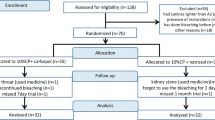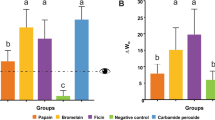Abstract
Objectives
This study aimed to develop and characterise a new three-component dental whitening formulation which is as effective as the currently used carbamide peroxide but at significantly lower hydrogen peroxide concentrations.
Materials and methods
The new formulation (Carbamide Plus) was prepared containing hydrogen peroxide, urea, and sodium tripolyphosphate and compared directly with carbamide peroxide (containing just hydrogen peroxide and urea). To evaluate the clinical effectiveness of 5 % Carbamide Plus, a randomised double-blind placebo-controlled clinical trial was conducted comparing the tooth colour of 33 patients using L*a*b* scores at baseline and after a 2-week whitening treatment. The behaviour of the three components in solution was determined by 1H and 31P NMR spectroscopy and pH dilution experiments.
Results
This clinical trial revealed that 5 % whitening gels containing Carbamide Plus were as effective as those containing 10 % carbamide peroxide. 1H and 31P NMR spectroscopy revealed strong intermolecular interactions between hydrogen peroxide and both urea and sodium tripolyphosphate (STPP) with little apparent interaction between urea and STPP.
Conclusions
In this manuscript, we postulate that this increased whitening efficiency is due to a marked increase in local pH upon dilution which destabilises the hydrogen peroxide and expedites the whitening process. We postulate Carbamide Plus to be a three-component adduct with two molecules of carbamide peroxide binding to a central STPP unit with no direct interaction between STPP and urea. There were no statistically significant differences between Carbamide Plus and 10 % carbamide peroxide in tooth-whitening achieved at 2 weeks. These results were recorded following 2 weeks of 2-h daily wear of at-home trays.
Clinical relevance
Carbamide Plus offers the potential of using significantly lower levels of hydrogen peroxide concentration to achieve similar dental whitening effects.










Similar content being viewed by others
References
Haywood VB, Heymann HO (1989) Nightguard vital bleaching. Quintessence Int 20(3):173–6
Andrew J (2006) The bleaching of teeth: a review of the literature. J Dent 34(7):412–9
Haywood VB (2000) Current status of nightguard vital bleaching. Compend Contin Educ Dent Suppl 2000(28):S10–7, quiz S48
Hattab FN, Qudeimat M, Al-Rimawi HS (1999) Dental discolouration: an overview. J Esthet Dent 11(6):291–310
Matis B, Gaiao U, Blackman D, Schultz F, Eckert G (1999) In vivo degradation of bleaching gel used in whitening teeth. J Am Dent Assoc 130(2):227–35
Pretty IA, Ellwood RP, Brunton PA, Aminam A (2006) Vital tooth bleaching in dental practice: 1. Professional bleaching. Dent Updat 33:288–304
Sulieman M (2006) An overview of bleaching techniques: 2. Night guard vital bleaching and non-vital bleaching. SADJ. 61(8):352, 354, 356
Cardoso PC, Reis A, Loguercio A, Vieira LCC, Baratieri LN (2010) Clinical effectiveness and tooth sensitivity associated with different bleaching times for a 10 percent carbamide peroxide gel. J Am Dent Assoc 141(10):1213–20
Bruzell EM, Pallese U, Rygh Thoresen N, Wallma C, Dahl JE (2013) Side effects of external tooth bleaching: a multi-centre practice based prospective study. BDJ 215:1–8
Dobado JA, Molina J, Portal D (1998) Theoretical study on the urea-hydrogen peroxide 1:1 complexes. J Phys Chem A 102(4):778–784
Fasanaro TS (1992) Bleaching teeth: history, chemicals, and methods used for common tooth discolorations. J Esthet Restor Dent 4(3):71–8
Dahl JE, Pallesen U (2003) Tooth bleaching—a critical review of the biological aspects. Crit Rev Oral Biol Med 14(4):292–304
Sulieman MAM (2000) An overview of tooth-bleaching techniques: chemistry, safety and efficacy. Periodontol 48(1):148–169
Kelleher MG (2008) Dental bleaching. Quintessence Publishing Co Ltd
Majeed A, Grobler SR, Moola MH (2011) The pH effects of various tooth-whitening products on the South African market. SADJ: J S Afr Dent Assoc 66(6):278–81
Sun G (2000) The role of lasers in cosmetic dentistry. Dent Clin North Am 44(4):831–50
Goldberg M, Grootveld M, Lynch E (2010) Undesirable and adverse effects of tooth-whitening products: a review. Clin Oral Investig 14(1):1–10
Frysh H, Bowles WH, Baker F, Rivera-Hidalgo F, Guillen G (1995) Effect of pH on hydrogen peroxide bleaching agents. J Esthet Dent 7(3):130–3
Basting RT, Amaral FLB, Franca FMG, Florio FM (2012) Clinical comparative study of the effectiveness of and tooth sensitivity to 10% and 20% carbamide peroxide home-use and 35% and 38% hydrogen peroxide in-office bleaching materials containing desensitizing agents. Oper Dent 37(5):464–73
Leonard R, Sharma A, Haywood V (1998) Use of different concentrations of carbamide peroxide for bleaching teeth: an in vitro study. Quintessence Int 29(8):503–7
Soviet Union patent SU-A-521224. 1973 25th May
White DJ (2002) A new and improved “dual action” whitening dentifrice technology—sodium hexametaphosphate. J Clin Dent 13(1):1–5
Shellis RP, Addy M, Rees GD (2005) In vitro studies on the effect of sodium tripolyphosphate on the interactions of stain and salivary protein with hydroxyapatite. J Dent 33(4):313–24
Sowinski J, Battista G, Petrone DM, Petrone ME, DeVizio W, Volpe AR et al (2000) A calculus clinical study comparing the efficacy of two commercially available dentifrices. J Clin Dent 11(3):68–71
Tanzer JM, Pellegrino J, Buch RM, Fares HM (2001) Caries inhibition in rats by a sodium fluoride, tripolyphosphate toothpaste with whitening and anti-tartar properties. J Clin Dent 12(4):108–11
Porciani PF, Grandini S (2003) A six-week study to evaluate the anti-calculus efficacy of a chewing gum containing pyrophosphate and tripolyphosphate. J Clin Dent 14(1):11–3
Porciani PF, Grandini S, Sapio S (2003) Anticalculus efficacy of a chewing gum with polyphosphates in a twelve-week single-blind trial. J Clin Dent 14(2):45–7
Connors KA (1987) Binding constants. The measurement of molecular complex stability. 1st ed Wiley
Sanderson JM, Whelan EJ (2004) Characterisation of the interactions of aromatic amino acids with diacetyl phosphatidylcholine. Phys Chem Chem Phys 6(5):1012–1017
Fielding L (2000) Determination of association constants (K(a)) from solution NMR data. Tetrahedron 56(34):6151–70
Basting RT, Amaral FL, França FM, Florio FM (2012) Clinical comparative study of the effectiveness of and tooth sensitivity to 10% and 20% carbamide peroxide home-use and 35% and 38% hydrogen peroxide in-office bleaching materials containing desensitising agents. Oper Dent 37(5):464–73. doi:10.2341/11-337-C
Xu B, Li Q, Wang Y (2011) Effects of pH values of hydrogen peroxide bleaching agents on enamel surface properties. Oper Dent 36(5):554–62
Acknowledgments
The authors acknowledge SMT Ltd and the Department of Learning (DEL) in Northern Ireland for a DEL CAST studentship. Dr. McDonald acknowledges part funding by SMT of the clinical trial.
Conflict of interest
Prof. Callan reports grants from null, during the conduct of the study.
Author information
Authors and Affiliations
Corresponding authors
Rights and permissions
About this article
Cite this article
Hyland, B.W., McDonald, A., Lewis, N. et al. A new three-component formulation for the efficient whitening of teeth (Carbamide Plus). Clin Oral Invest 19, 1395–1404 (2015). https://doi.org/10.1007/s00784-014-1352-9
Received:
Accepted:
Published:
Issue Date:
DOI: https://doi.org/10.1007/s00784-014-1352-9




